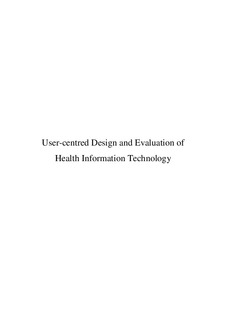| dc.contributor.author | Smáradóttir, Berglind Fjóla | |
| dc.date.accessioned | 2016-09-19T09:22:03Z | |
| dc.date.available | 2016-09-19T09:22:03Z | |
| dc.date.issued | 2016 | |
| dc.identifier.isbn | 978-82-7117-830-7 | |
| dc.identifier.issn | 1504-9272 | |
| dc.identifier.uri | http://hdl.handle.net/11250/2408264 | |
| dc.description | Doktorgradsavhandling i informasjons- og kommunikasjonsteknologi, Fakultet for teknologi og naturvitenskap, Universitetet i Agder | nb_NO |
| dc.description.abstract | Health information technologies play an important role in exchange of information and coordination of continuity of care in health care services. This thesis explores the approach of user-centred design and evaluation in the development of health information technology, with the main research focus on end-user involvement. A study on user-centred design and evaluation in the externally funded research projects United4Health and eHealth- extended Care Coordination was conducted. In addition, the internal project Visually impaired users touching the screen - A user evaluation evaluated visually impaired users using mobile technology. In the EU project United4Health, a collaborative telemedicine system for remote monitoring of chronic obstructive pulmonary disease patients was developed. The regional project eHealth- extended Care Coordination addressed the information flow within inter-municipal health care teams to build a collaborative information system that facilitated coordination between municipalities. In both projects, end-users were involved in workshops in an early design phase and participated in usability evaluations during the iterative development. A mixed methods research approach including observations, semi-structured interviews and a questionnaire was used for data collection in the user-centred design process. The data analysis was based on a qualitative content analysis from a human-computer interaction perspective. This thesis also addresses the topic of the usability evaluation of health information technology from the perspective of the technical infrastructure necessary for optimisation of data collection and retrospective analysis of data. In this regard, a usability evaluation of a mobile touchscreen together with visually impaired users was made.
The results from the user-centred design and evaluation research are presented in this dissertation through a collection of 9 scientific published papers in international peer-reviewed journals and conference proceedings. This study contributes to the knowledge of user-centred design in several ways. Firstly, this thesis provides an understanding on how to actively and efficiently involve users in design and development of health information technology by conducting empirical research. Secondly, it contributes to the knowledge on how to run usability evaluations of health information technology in high fidelity laboratory settings, health care environment and patients’ homes. Thirdly, it provides recommendations for a technical infrastructure in order to optimise the outcome of usability evaluations. The Norwegian Social Science Data Services approved the studies presented here. | nb_NO |
| dc.language.iso | eng | nb_NO |
| dc.publisher | Universitet i Agder / University of Agder | nb_NO |
| dc.relation.ispartofseries | Doctoral dissertations at University of Agder; | |
| dc.relation.ispartofseries | ;137 | |
| dc.rights | Navngivelse-Ikkekommersiell-DelPåSammeVilkår 3.0 Norge | * |
| dc.rights.uri | http://creativecommons.org/licenses/by-nc-sa/3.0/no/ | * |
| dc.title | User-centred Design and Evaluation of Health Information Technology | nb_NO |
| dc.type | Doctoral thesis | nb_NO |
| dc.subject.nsi | VDP::Technology: 500::Information and communication technology: 550 | nb_NO |
| dc.source.pagenumber | XXII, 252 s. | nb_NO |

